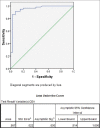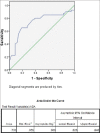Diagnostic utility of pleural fluid carcinoembryonic antigen in patients with exudative pleural effusion
- PMID: 33687007
- PMCID: PMC8098895
- DOI: 10.4103/lungindia.lungindia_196_20
Diagnostic utility of pleural fluid carcinoembryonic antigen in patients with exudative pleural effusion
Abstract
Background: Pleural effusion (PE) is presenting symptoms of many different diseases and is often a diagnostic challenge. Negative cytology in the malignant PE requires more complicated diagnostic procedures, such as closed pleural biopsy or thoracoscopic pleural biopsy. Not all the patients will be fit for such invasive procedures due to high risk. Tumor markers seem to be a promising alternative and have been proposed to aid in the differentiation of the PE etiology.
Objective: The objective of the study was to evaluate the diagnostic value of pleural fluid carcinoembryonic antigen (CEA) in differentiation between malignant and nonmalignant PEs and to compare adenosine deaminase (ADA) levels with respect to malignant and nonmalignant PE.
Methodology: It was a prospective observational study. Patients who presented with undiagnosed exudative PE during the time period 2016-2018 were studied. Pleural fluid was subjected to all routine investigations such as sugar, protein, lactate dehydrogenase, ADA, and CEA.
Results: A total of 100 patients were included in the study. Fifty-one patients had malignancy. Univariate analysis showed that smoker, previous history of cancer, ADA <20, and CEA of >2.15 were variables associated with malignancy. Multivariate analysis showed pleural fluid CEA >2.15 as only independent risk factor associated with malignancy. The sensitivity of 91.5% and 65% and specificity of 92.5% and 81.4%, respectively, were found for CEA 2.15 ng/dl and ADA <16.5 U/L as plotted from receiver operating characteristic curve. The combined CEA and ADA (2.39 ng/ml and 16.5 U/L) values in pleural fluid had higher sensitivity of 100%.
Conclusion: Our study demonstrated that pleural fluid CEA levels have a sensitivity of 93.5% and specificity of 73% in diagnosing of malignant PE. ADA levels lesser than 16.5 U/L were seen in patients with malignant PE, but less sensitive and specific compared to CEA. Combined ADA and CEA levels had higher sensitivity than CEA alone.
Keywords: Adenosine deaminase; carcino embryonic antigen; lung cancer; pleural effusion.
Conflict of interest statement
None
Figures
Similar articles
-
Diagnostic Accuracy of Pleural Fluid Cytology, Carcinoembryonic Antigen and C-Reactive Protein Together in Patients With Pulmonary Metastases and Malignant Pleural Effusion.Anticancer Res. 2020 Oct;40(10):5877-5881. doi: 10.21873/anticanres.14607. Anticancer Res. 2020. PMID: 32988918
-
Diagnostic utility of adenosine deaminase in exudative pleural effusions.Lung India. 2014 Apr;31(2):142-4. doi: 10.4103/0970-2113.129842. Lung India. 2014. PMID: 24778477 Free PMC article.
-
Diagnostic utility of serum and pleural fluid carcinoembryonic antigen, and cytokeratin 19 fragments in patients with effusion from nonsmall cell lung cancer.J Carcinog. 2015 Nov 27;14:7. doi: 10.4103/1477-3163.170662. eCollection 2015. J Carcinog. 2015. PMID: 26900349 Free PMC article.
-
Diagnostic value of periostin in lung cancer-related malignant pleural effusion.J Clin Lab Anal. 2022 Feb;36(2):e24179. doi: 10.1002/jcla.24179. Epub 2021 Dec 27. J Clin Lab Anal. 2022. PMID: 35152510 Free PMC article.
-
Evaluation of predictive value of pleural CEA in patients with pleural effusions and histological findings: A prospective study and literature review.Clin Biochem. 2016 Nov;49(16-17):1227-1231. doi: 10.1016/j.clinbiochem.2016.08.006. Epub 2016 Aug 10. Clin Biochem. 2016. PMID: 27521620 Review.
Cited by
-
Clinical Value of Pleural Effusion and Serum MMP-3 and CYFRA21-1 Combined with ADA in Differential Diagnosis of Pleural Exudative Effusion.Emerg Med Int. 2022 Aug 29;2022:1615058. doi: 10.1155/2022/1615058. eCollection 2022. Emerg Med Int. 2022. Retraction in: Emerg Med Int. 2023 Dec 20;2023:9765351. doi: 10.1155/2023/9765351. PMID: 36072615 Free PMC article. Retracted.
-
Exosomal miRNA-profiling of pleural effusion in lung adenocarcinoma and tuberculosis.Front Surg. 2023 Jan 6;9:1050242. doi: 10.3389/fsurg.2022.1050242. eCollection 2022. Front Surg. 2023. PMID: 36684253 Free PMC article.
-
The Use of "Cancer Ratio" in Differentiating Malignant and Tuberculous Pleural Effusions: Protocol for a Prospective Observational Study.JMIR Res Protoc. 2024 Dec 23;13:e56592. doi: 10.2196/56592. JMIR Res Protoc. 2024. PMID: 39715545 Free PMC article.
References
-
- Sahn SA. The pleura. Am Rev Respir Dis. 1988;138:184–234. - PubMed
-
- Miserocchi G, Agostoni E. Contents of the pleural space. J Appl Physiol. 1971;30:208–13. - PubMed
-
- Light RW. Lippincott Williams and Wilkins. 4th ed. 2001. Physiology of pleural space. In: Pleural Disease; pp. 8–16.
-
- Light RW. Clinical practice.Pleural effusion. N Engl J Med. 2002;346:1971–7. - PubMed
-
- Sahn SA, Huggins JT. Malignant Pleural effusions, Fishman's Pulmonary Diseases and Disorders. Mc Graw Hill Medical, New York. (5th Edition) 2015:1505–1516.
LinkOut - more resources
Full Text Sources
Other Literature Sources
Research Materials



